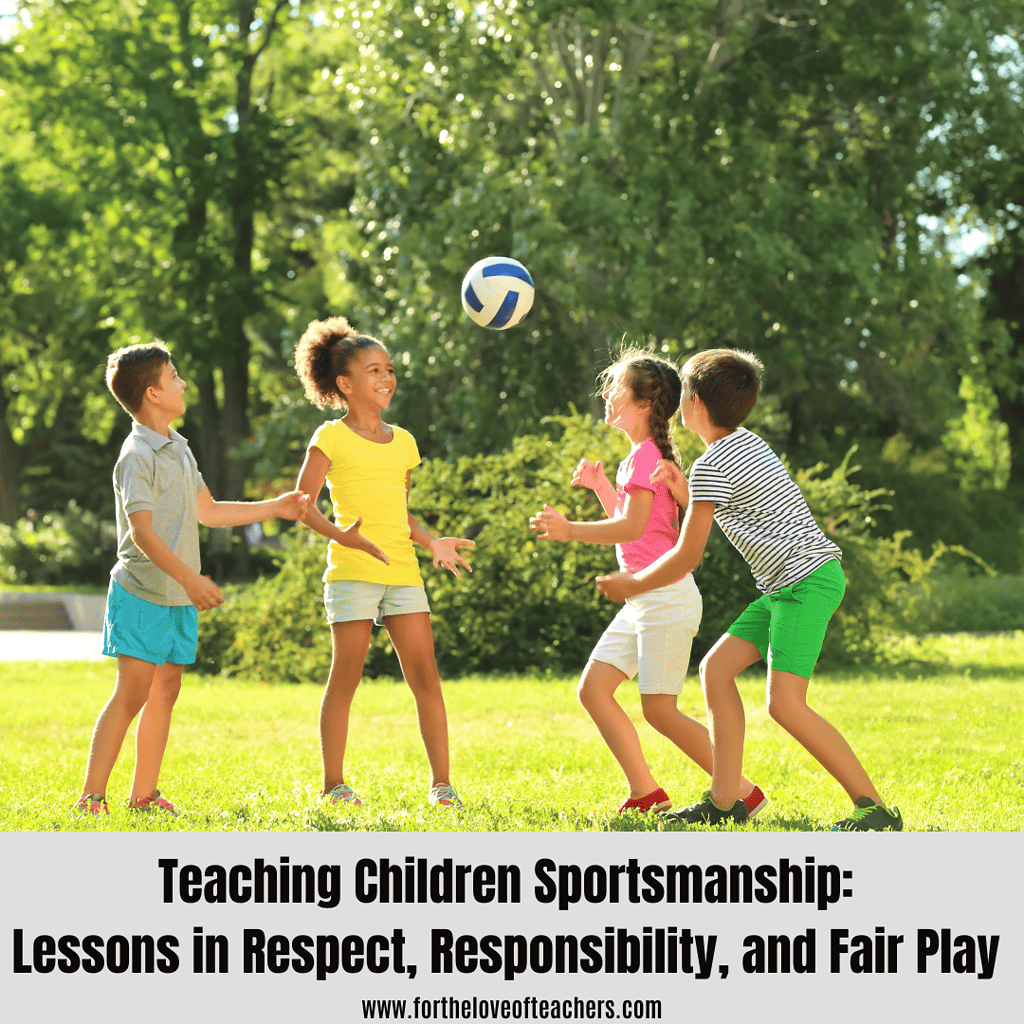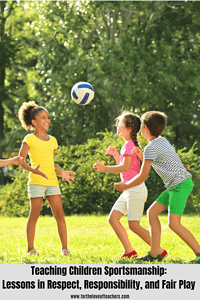When children start playing sports at a young age, they are exposed to different scenarios – like emerging as victors for a tournament they’ve been training months for or even losing a game that they thought they had in the bag. In sports, anything can happen. But when losing can become too frequent or too painful, it’s easy for children to build unsportsmanlike behavior.
That’s where teachers come into the picture. Teaching sportsmanship doesn’t have to happen on the field, it can start in your very own classroom. In this article, we’ll get into the details of everything about sportsmanship – its definition, the how-tos, and the challenges.
What Is Sportsmanship?
Sportsmanship is all about playing the sport with fairness. Win or lose, sportsmanship is one value that all children must learn at a young age. It builds respect, fairness, self-control, and integrity. You see, this value goes beyond the “sports” in “sportsmanship” as it develops their character and allows them to build positive relationships with the people around them.
Signs of Poor Sportsmanship
Have you ever wondered if your students were in need of a short refresher on the meaning of sportsmanship? Here are some signs that a student has poor sportsmanship:
- When playing games, it often turns out badly – verbal argument, physical harm, or bullying.
- They have difficulty regulating their emotions in the classroom and in games.
- The student sulks for the rest of the day when they lose a competition.
How to Teach Sportsmanship to Children
Fortunately, children can be easily taught the value of sportsmanship. As a teacher, you’ll have to put in some work to ensure that these kids instill this important value. Here’s how you can achieve that:
Show Them Videos About Sportsmanship
Some children retain information better when watching videos about sportsmanship, which is why showing them can help them learn more about it. Videos that display real-life situations of how people act in sports can give them an idea of what true sportsmanship is like. For instance, you can show a video of a heated tournament of volleyball, and later on, see the players exchange high-fives once the game is over. While this may seem like a simple gesture, it shows that all is well between the two teams – no feelings of disrespect or anger.
Incorporate It Into Your Classroom Activities
Another way to keep them involved while learning about sportsmanship is by incorporating sportsmanship into your classroom activities. A brilliant example to do this is through engaging them in a poster-making activity. For this activity, students can draw anything they want – as long as it displays sportsmanship. They can even write a quote and add their own designs. Once they’re done with their work, plaster them on the walls of your classroom. Not only does it improve your classroom decor, but also it serves as a daily reminder to them about the value of sportsmanship. Such activities in the classroom also promote the significance of maintaining a healthy balance between sports and school.
Be a Role Model
Children learn by imitating the behavior of others. And being a teacher, you’re placed in a position where you can greatly influence their character. That’s why it’s crucial that you be a role model to them by displaying values of sportsmanship in your daily life, like showing empathy.
For example, that means cheering on a student when they try something new even when failing. Show that they shouldn’t solely focus on the achievements, but also the effort. You must also exhibit sportsmanlike behavior, such as not using negative language. And in the event that they throw a tantrum and start kicking their sports bag, that’s the time to tell them to stop – you shouldn’t condone that behavior. Note that there are many ways you can model sportsmanlike behavior and that you have a huge role to play in building their character.
Challenges in Teaching Sportsmanship
Of course, teaching sportsmanship to children isn’t always sunshine and butterflies. Sometimes, the road to achieving that can get a little bumpy. But with awareness of these challenges, inculcating the value of sportsmanship can be a little easier.
The environment of a child plays a huge role in building their character – their family, their friends, their teammates, their classmates, and their teachers. Even the media they’re exposed to can affect their behaviors. While we cannot fully control their environment, teachers must foster a positive classroom environment to solidify their students’ sportsmanlike behavior.
Some students may take longer to teach than others – and that’s okay. All students are different – different backgrounds, different upbringings, and different environments. With all these factors coming into play, it’s easy to see why teaching sportsmanship can get difficult, although not impossible.
In Conclusion
Teachers play an influential role in the behavioral development of children. By instilling values of sportsmanship, children are more likely to build positive relationships with others. They will learn how to respect others, have empathy for them, and be models of fairness and integrity. And these values are what they will carry with them for the rest of their life.
How do you teach sportsmanship? Share in the comments.
About the Author: Sophia Young recently quit a non-writing job to finally be able to tell stories and paint the world through her words. She loves talking about fashion and weddings and travel, but she can also easily kick ass with a thousand-word article about the latest marketing and business trends, finance-related topics, and can probably even whip up a nice heart-warming article about family life. She can totally go from fashion guru to your friendly neighborhood cat lady with mean budgeting skills and home tips real quick.
Thanks for reading!
If you like it, then pin it!

Christine Weis is a passionate educator, classroom management coach, wife, and mom of two busy boys. She enjoys teaching, writing, and creating resources for teachers.







I agree with you, this is very important that children need to learn about Sportsmanship. I know about this but not the term you used.
Teaching children sportsmanship lessons is so important. It can help them a lot in future.
This is very important topic to share with others. It’s important to teach children at an early age about sportsmanship so they know how to handle each situations especially in times of being defeated.
Hihi….I guess I would make a terrible sports=person. I usually sulk for several hours, when my favourite teams lose or sometimes, draw!
I never really thought about it, but this is so important for kids to learn. Will save this article for later if I have kids!
My sister is a girl soccer team assistant coach. I just shared with her your article as it was a such a great read about good sportsmanship. The girls on their team could learn a lot from this.
Thanks for sharing this informative article with us. As early as possible, kids should be taught these behaviors and things.
These are such important issues to teach kids. I have seen so many issues with sportsmanship over the years, even with my kids being in high school now. Frustrating that it is such an issue.
Good sportsmanship is a key lesson as a child. Whether learned from team sports or even just gym class, it really forms who you become as an adult.
It’s good to instill good sportsmanship at early stages of a child’s life indeed. It will help them maneuver through the challenges of life more positively
This is a really great and wonderful article. Teaching kids these behaviors or things as early as possible is really important.
Teaching kids about respect, responsibility, and fair play through sports is a wonderful idea. They will become responsible adults in the future.
I think the most important thing is to be a good role model. Children pick up on how their parents act, not what they say.
Good sportsmanship is one of the life lessons that children can learn from sports. Great skill to learn while they are young.
Parents and kids alike love sports, and it’s easy to get caught up in a game and become focused on winning. Yet there is much more to be gained from the sports experience than a winning record. Responsibility, sportamanship; these are great things to teach kids!
Teachers significantly impact shaping children’s behaviour, and instilling values of sportsmanship is crucial. By promoting fairness, respect, and empathy, teachers can help children develop positive relationships with others that will benefit them for the rest of their lives. It’s lovely to see educators recognize the importance of these values and work to instil them in their students.
Great skills for children to learn at a young age. My favorite is for the teacher to be a good role model.
Your article on teaching sportsmanship is insightful and practical. The tips and examples provided are valuable tools for educators to instill this important value in children. Your engaging writing style makes it an enjoyable read, and your passion for shaping young minds shines through. Great work! 🏆👏
What an excellent resources for teachers and educators. I have a number of friends who are teachers, I’m sure they’d love the space you’ve created here.